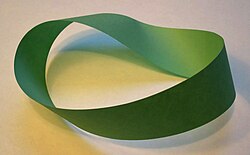
Maze of artists rendition of the inside of a Mobius Strip.
What is a Mobius Strip?
Mobius Strip on
Wikipedia
The Möbius strip or Möbius band (pronounced UK: /ˈmɜːbiəs/ or US: /ˈmoʊbiəs/ in English, [ˈmøːbi̯ʊs] in
German) (alternatively written Mobius or Moebius in English) is a surface with only one
side and only one boundary component.
The Möbius strip has the mathematical property of being non-orientable.
It
can
be
realized
as
a ruled
surface.
It was discovered independently by the German
mathematicians August
Ferdinand
Möbius and Johann
Benedict Listing in 1858.[1][2][3]
A model can easily be created by taking a paper strip and giving it a half-twist, and then joining the ends of the strip together to form a loop. In Euclidean space there are in fact two types of Möbius strips depending on the direction of the half-twist: clockwise and counterclockwise. The Möbius strip is therefore chiral, which is to say that it has "handedness" (right-handed or left-handed).
It is straightforward to find algebraic equations the solutions of which have the topology of a Möbius strip, but in general these equations do not describe the same geometric shape that one gets from the twisted paper model described above. In particular, the twisted paper model is a developable surface (it has zero Gaussian curvature). A system of differential-algebraic equations that describes models of this type was published in 2007 together with its numerical solution.[4]
The Euler characteristic of the Möbius strip is zero.
Top Twelve Places to Download Mobius Maze
- Picassa
Web
Just
Do
It
Nike
Maze
- Mobius Maze on Devian Art
- Maze of Mobius Strip on Fine Art America
- Mobius Maze on Flickr
- Optical
Illusion
Mazes
on
Facebook
- Maze of Mobius Strip on TwitPic
- Mobius Maze Online
- Maze of Mobius Strip on Photobucket
- Mobius Maze on Saatchi Online
- Twisted Mobius Maze on Live Journal
- Mobius Maze on Picassa
- Mobius
Maze
on Team Of Monkeys . com
Some other popular mazes:
Click here to google image search the word "maze" - We come up a few times!
